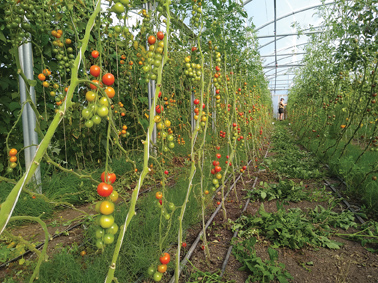
As always, the weather in July has been favourable to some crops and not so liked by others. Lots of sun and high temperatures have meant that all of the summer fruiting and heat loving crops like tomatoes, peppers, cucumbers, squash and courgettes have done really well. The lack of rain has been more problematic for crops like celeriac, and we have had difficulties with carrot germination this year too. We have been irrigating more than we ever have done in the past, and needing to damp down polytunnel crops with our overhead irrigation to increase humidity and reduce the temperatures for some of the fruiting crops to reduce flower drop.
August brings the last chance to sow some of the autumn crops and the end of the month can be seen a little like a second Spring sometimes—with all of the July sowings being planted and establishing. We usually sow winter radish which come in a huge range of shapes and colours, as well as salad turnips (which are very underrated and are hardly anything like the winter turnips that people are more familiar with). Mustards and other salad leaves and herbs are sown through August to provide leaves through early autumn too.
It’s a busy month in terms of planting out various autumn crops such as chicory, chinese cabbage, lettuce, fennel and endive—all of which we grow a lot of through the autumn as the growth rate reduces, so we need to grow a lot more than we do through the summer to ensure that we have plenty to keep us going through the autumn. All of these crops are planted out or sown directly into beds that have already had one or two crops in this year. After the first crops come to the end we usually mow them down and then water the beds before covering with black plastic to help kill off the old crops and any weeds. This is usually done around 3 weeks before the beds are to be planted again, and then the plastic is taken off and the beds usually raked out and planted directly into.
August is a good month to establish green manures, and we experimented a lot last year with undersowing many of the August planted crops with linseed, buckwheat and black oats. We would normally hoe any newly planted crops about a week after planting, then about a week after the first hoeing we would sow the green manures over the crop—usually just broadcasting the seed by hand, but sometimes drilling the seed with a seed drill. We then hoe in the seed, which acts as a second hoeing of the crop but also ensures the seed is lightly mixed into the top layer of soil so that there is a better soil to seed contact and the seed germination rate is improved. The green manures then slowly establish whilst the crop grows, and by late autumn once the crops like lettuce, endive and fennel have been harvested the green manure then has more space to grow into and it covers the bed. This means that there are more living roots in the soil through the winter, and the green manures are more established than if you sow them in September so the soil is in better health going into Spring.
WHAT TO SOW THIS MONTH: endive, winter purslane, salad mustards (best sown direct) such as Golden Streaks, Purple Frills, rocket, land cress, chard, leaf radish, texsel greens, lettuce, fennel (early in the month), broad beans (for tips in salads) & peashoots, autumn radish and turnips, chinese cabbage and pak choi (early in the month), parsley (for overwintering in polytunnel/glasshouse), corn salad & spring onions & spring cabbage (all late in month for overwintering)
WHAT TO PLANT THIS MONTH:
OUTSIDE: fennel, beetroot, lettuce, chard, kohl rabi, chicory, salad leaves: buckshorn plantain, salad burnet, chervil, endive, turnips and winter radish (sown direct), pak choi and chinese cabbage
INSIDE: summer purslane, goosefoot
OTHER IMPORTANT TASKS THIS MONTH:
Keeping on top of taking old crops out and planting with new crops is still important throughout August. There is still plenty of time to get late crops in the ground, and as we roll into September it can almost be like a second spring (with the benefit of already warm soil)
Generally it is a time to harvest—keeping on top of harvesting courgettes and beans will keep them going and mean that they don’t get too big or too stringy. Also continue with the weekly job of sideshooting tomatoes and removing lower leaves to get good airflow going through the crop.




